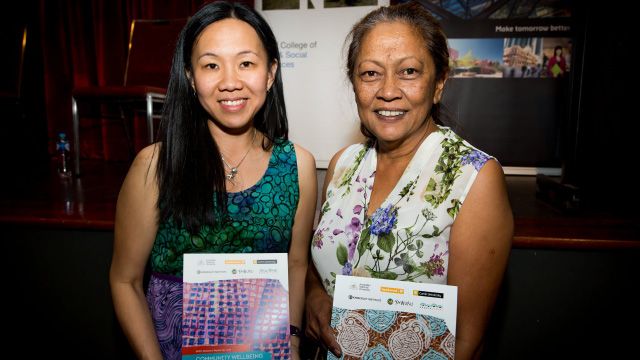Partnerships the way to determine Indigenous community's wellbeing

Mandy Yap (left) and Eunice Yu with their report, which features cover designs by Yawuru artists. Image by Julia Rau Photography.
Fishing in the scenic waters off Broome, Western Australian, wasn’t part of Australian National University PhD candidate Mandy Yap’s research proposal.
But Mandy, who’s based in the ANU Centre for Aboriginal Economic Policy Research (CAEPR), says that adventure with local Yawuru women was one of many during her three-year study into Indigenous well-being.
“I’m a city person and had never done anything like that before,” she says, laughing.
“The personal journey of this research has been as important as the intellectual journey. To be able to see first-hand what the numbers of the stories tell with the acts of people doing it, is a privilege that not everyone gets to have.”
These stories form the backbone to the report Community Wellbeing from the Ground Up: A Yawuru Example, which involved CAEPR, the Yawuru community, the Bankwest Curtin Economics Centre at Curtin University and the Kimberley Institute.
Among its findings: 93 percent of Yawuru people said ‘strong’ or ‘very strong’ family connections were important to them, which includes not just their nuclear family but the extended kinship and social structures.
More than 80 percent of respondents said that in the previous month, they shared or received food which was caught or hunted.
“There’s a social connection aspect, but also material or standard of living aspect to it, if that catch is supplementing your food intake that’s not being bought at a store,” Mandy says.
A researcher at CAEPR since 2007, many of her research findings to date relating to Indigenous people’s social and economic circumstances used Census or other survey data. Mandy wondered if those numbers represented reality, and sought to find a way to involve Indigenous voices in how their communities are evaluated throughout the research process.
Enter Nyamba Buru Yawuru Chief Executive Officer and ANU Council board member, Peter Yu, who has had a long relationship with CAEPR experts.
Mandy and Peter met in Broome in 2013, and along with co-author Eunice Yu from the Kimberley Institute, agreed to work together.
“We see this not merely as a collaboration but as a co-production of knowledge, bringing together Western and Indigenous ways,” Mandy says.
Eunice adds the purpose of developing indicators of wellbeing for Yawuru is to determine how Yawuru are faring according to their own benchmarks and standards.
“The findings from the Yawuru Wellbeing Survey show that there are many factors that contribute to achieving and maintaining wellbeing for Yawuru, but particularly connectedness to culture, country and family and self-determination.”
But before any surveys could be conducted, Mandy had to win the locals’ trust and respect. Her respectful engagement, her cooking and being from Malaysia – a major source of pearl farmers in multicultural Broome’s history – all helped.
“We cooked for all of the focus groups and Eunice and I probably made 300 dumplings,” Mandy recalls.
“I think the act of taking the time to do something for another person; it’s an important ice-breaker or offering.”
Peter Yu says the report will be crucial in helping his people make future social and cultural development investment decisions.
“Yawuru have devoted resources to the revitalisation of language, reconnection of culture, management of waters and lands, improved housing for our people, building the capacity of our youth and caring for our senior people,” Peter says.
“The survey findings will help determine the success of Yawuru native title rights.”
An earlier version of Mandy and Eunice’s study was published in the journal Oxford Development Studies.